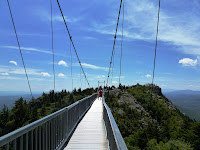One of the great hikes at Grandfather Mountain is the trail to the mile high swinging bridge which is located near Linville Peak. The hike to the mile high swinging bridge is spectacular as it offers stunning views over the North Carolina high country. The hike is a loop that utilizes the Bridge Trail, the Grandfather Trail and the Grandfather Trail Extension.
Directions to Trailhead: The entrance to Grandfather Mountain is located on US 221, two miles north of Linville, North Carolina, and one mile south of the Blue Ridge Parkway at milepost 305. The street address for the entrance is: 2050 Blowing Rock Highway, Linville, NC 28646. The road to the summit is referred to as Grandfather Mountain Entrance Road, Linville, NC. Once inside Grandfather Mountain follow the road to the Grandfather Mountain trails parking area, there is a sign for the parking area just before you reach the Top Shop area at the end of the road. For a map of the location where Grandfather Mountain is click Here. For a map of trails at Grandfather Mountain click Here.
Description of Hike: The hike to the mile high swinging bridge at Grandfather Mountain is a loop that utilizes several trails. The trail is well maintained however much of the trail contains uneven rocks and roots from nearby trees. From the parking area take the Bridge Trail 0.4 miles to the Top Shop area. It is at this point that you cross the mile high swinging bridge (Actually it is more than a mile high), to Linville Peak which is 5,303 feet in elevation and provides great views of Grandfather Mountain and the surrounding North Carolina Mountains. Return back across the bridge and cross the parking area and take the Grandfather Trail to proceed back down to the parking area. In just under 0.4 miles from the Top Shop area at the mile high swinging bridge you will intersect with the Grandfather Trail Extension which will take you back to the the Trails Parking area at Grandfather Mountain. From the trail intersection to the Parking area is 0.6 miles for a total hike of approximately 1.6 miles roundtrip and approximately 350 feet of elevation gain. We would classify this as a moderate hike due to the intensity of the terrain. There is a fee per person to enter Grandfather Mountain, for current costs click Here. If you want a longer hike you can hike to MacRae Peak which is located at an elevation of 5,845 feet. This will add an additional 1.2 miles roundtrip and an additional 400 feet in elevation gain for a total hike of 2.8 miles and 650 feet of elevation gain, which we classify as strenuous. For more information about this add on to MacRae Peak click the link below.
Further Thoughts: The hike to Grandfather Mountain's mile high swinging bridge is a must do when you visit Grandfather Mountain. The terrain the hike goes through is unparalleled and the views continue to get better the higher up the mountain you go. We found that the trails were well marked and were well maintained by park staff. Additionally, since this is a popular hiking trail at Grandfather Mountain, you will likely see other visitors out enjoying the trails.
The Mile High Swinging Bridge was built to give visitors easy access to the breath-taking view from Grandfather Mountain's Linville Peak. The 228-foot suspension bridgespans an 80-foot chasm at more than one mile in elevation. Surveys by the staff at Grandfather Mountain have shown that the journey to the other side of the mile high swinging bridge is always considered the highlight of a trip to Grandfather Mountain.
The Mile High Swinging Bridge was originally constructed in 1952 and was rebuilt in 1999 using the original towers. The cables, floor boards and side rails were all replaced using galvanized steel. One of the main advantages of the modern building materials is that they do not have to be painted. Now Grandfather Mountain employees will not have to hang out over the gorge to paint the span. The 228-foot steel structure is America's highest suspension footbridge.
Rating: Elevation Gain: 350 ft. (Moderate), Distance: 1.6 Miles (Moderate).













